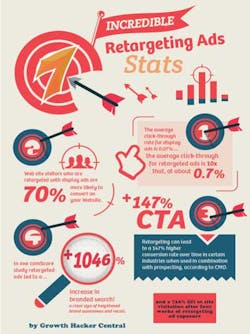Retargeting your dental practice with Google display network ads
What is the Google Display Network Ad? Google Display Ads run at the top or side of the page on millions of websites such as YouTube, Blogger, Google Search, and more. Whether you love or hate big data, it is always working behind the scenes. Google wants to make every user’s experience top notch. Their web spiders track everything we do, and this allows them to display ads that are relevant to our needs and desires and enhance their users’ experience.
Remarketing or retargeting with Google’s Display Network Ads might be the best way to use your Adwords account. What you’re essentially doing is remarketing to potential patients who have already visited one of your web pages, or searched on Google for a keyword you feel will bring in lots of new patients. For example, if a potential customer searches for “affordable dental implants,” then you can make sure your display ad shows up when these keywords are searched.
If you’ve been following Growth Hacker Central’s blog site, then you know we suggest attaching a blog to your website. The blog posts published on this site will also be published on social media in order to drive patients back to your website. The ultimate goal is to have them read not just one blog, but to engage them to the point they will surf your website and call for an appointment. Another advantage is enhanced SEO, since you will be using social media and creating more positive social media comments and backlinks to your website with your blogs.
But let’s face it, many potential patients might just read your blog and then click away from your site. They showed enough interest in you to read your blog post, so why not try to re-engage them and convince them you’re the dentist they need to start using! If they keep seeing your ads, they’ll be more likely to revisit your website and convert to care.
Remarketing allows you to focus on the folks who have already visited your website. It just makes sense that your ROI from remarketing to these parties will be higher than the ROI from marketing to people who have never shown an interest in you.
On that same note, it’s smart marketing to use the Google Display Network to focus on users who search for terms that will make them qualified prospects. The first step is to choose the best search keywords for your practice’s services. You might want to bid less on less specific keywords such as “family dentist.” Long tail keywords, which are longer and more specific keyword phrases, could possibly bring in a higher quality patient. You need to test what keywords produce the highest quality patients for your practice, and track it with your Google Adwords/Google Analytics account before spending a lot of money on a Google Display Network Ad Campaign.
Here are some best practices for remarketing or retargeting with the Google Display Ad Network:
1) Focus your remarketing efforts – You can change your settings in your AdWords account to focus on a certain gender or age group. Maybe baby boomers are your best market. Maybe you want to target women. AdWords allows you to focus in on specific, targeted groups of potential patients. Always test every idea with a small amount of money. You can set your cap easily with AdWords.)
2) Decide on member duration – Google Display Ads will retarget or remarket to the users who have visited your website by showing your ads on the users’ searches for 180 days after their initial visit to your website, unless you set different parameters. You might only want to target these people for 30 or 90 days. You have to decide through testing and tracking results what parameters work best for you.
3) Cap the frequency so users don’t see your ads more than you want – Frequency refers to the average number of times a unique user will see your display ad over a given period of time. Google will keep displaying your ads until you tell it how many times it is allowed each day. For example, if you want your user list to see your ads three times a day, you have to set up an ad frequency cap, otherwise you might be paying for a user to see your ads a million times per day.
4) Include images in your Google remarketing ads – Images have been proven to perform better than ads with just text. This is not a guess. It is a fact proven by Google Analytics. Many companies have seen an increase in ROI of 50% by adding images to their ads.
I encourage you to begin using Google Display Network Ads slowly to get a feel for the potential. If you keep your bid low, track your results from the different keywords and parameters you set up, then you can track your ROI and bid more. The more ROI you see from different parameters, the more you can bid! This will be fun and better for your dental practice than any other use of your time and money. You could think of it like gambling, yet unlike gambling, you will also be building your practice me. The goal is to make money, not burn it. Start small.
ALSO BY LISA NEWHOUSE:
9 tactics for growth hacking your dentist SEO and SMO strategy
3 tricks for using Google+ for dentist SEO better than your competition
Do you need help setting up your Google Display Network Ad parameters? Growth Hacker Central can help. Call 800-875-9066 or email [email protected] today.

